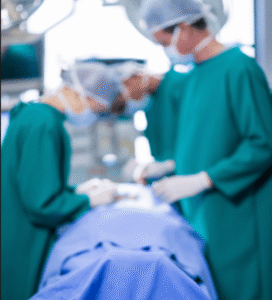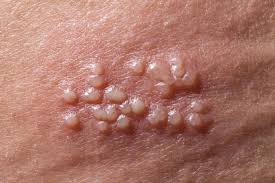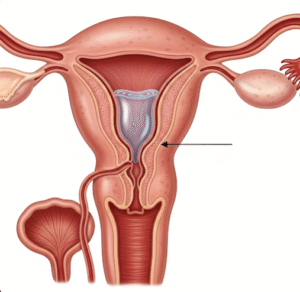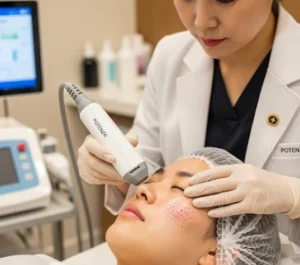What It Is
The Bilateral Sagittal Split Osteotomy (BSSO) is a lower jaw (mandible) surgery designed to correct bite misalignment and improve both facial balance and function. During this procedure, the mandibular bone is cut on both sides and repositioned, allowing surgeons to move the lower jaw forward, backward, or sideways depending on the patient’s needs.
In Korea, BSSO is commonly performed as part of two-jaw (orthognathic) surgery, often paired with Le Fort I osteotomy of the upper jaw. Korean surgeons are known for their advanced surgical planning, combining 3D imaging, virtual simulations, and custom fixation plates to ensure precise outcomes with a strong focus on both aesthetics and function.
Why It’s Done
Medical Purposes:
- Corrects malocclusion (overbite, underbite, crossbite, or open bite)
- Improves chewing, speaking, and overall oral function
- Treats jaw asymmetry or skeletal irregularities
- Alleviates temporomandibular joint (TMJ) issues in some patients
Cosmetic Purposes:
- Refines lower face proportions
- Slims or repositions the jawline for a more harmonious appearance
- Often combined with chin surgery or V-line contouring for balanced aesthetics
Patient Factors:
- Best for adults after facial growth is complete
- Common among patients with skeletal discrepancies not correctable by orthodontics alone
- Chosen by international patients seeking both bite correction and facial harmony
Alternatives
- Orthodontics Alone: Effective for mild malocclusion but cannot correct skeletal jaw issues
- Chin Augmentation or Implants: Cosmetic-only changes without bite correction
- Masseter Botox: Slims the jaw muscles but does not correct bone alignment
- Single Jaw Surgery: For less severe discrepancies, only one jaw may need repositioning
Preparation
Before undergoing BSSO in Korea, patients typically go through:
- Comprehensive Consultation: With orthodontists, oral surgeons, and plastic surgeons
- 3D Imaging & CT Scans: For accurate assessment and surgical simulation
- Orthodontic Treatment: Braces or aligners to align teeth before and after surgery
- Health Screening: Blood tests and medical history evaluation
- Lifestyle Adjustments: Stop smoking, alcohol, and blood-thinning medications several weeks before surgery
- Fasting: Required 6–8 hours prior to general anesthesia
How It’s Done
Type: Major surgical procedure under general anesthesia
Duration: 3–5 hours, depending on case complexity
Step-by-Step:
- Incisions are made inside the mouth (no visible scars)
- The surgeon carefully cuts the mandible on both sides
- The jawbone is repositioned forward, backward, or to one side as planned
- Titanium plates and screws secure the jaw in its new position
- Incisions are closed with dissolvable sutures
Hospitalization: 2–4 days in the hospital for monitoring and pain management
Recovery
- First Week: Significant swelling and mild bruising; pain controlled with medication
- Diet: Strictly liquid or soft food diet for several weeks
- Oral Care: Antiseptic mouth rinses essential for hygiene due to intraoral incisions
- Downtime: Most patients return to light activities after 3–4 weeks
- Orthodontics: Continued braces or aligners post-surgery to fine-tune bite alignment
- Final Results: Fully visible within 3–6 months; complete healing can take 9–12 months
Possible Complications
- Swelling and bruising (expected during recovery)
- Temporary numbness of the lower lip or chin due to nerve involvement (usually improves over time)
- Infection at incision sites (rare with proper care)
- Jaw stiffness or limited movement during healing
- Relapse or asymmetry if bone shifts (rare with modern surgical fixation)
- Rare but possible long-term nerve changes
Treatment Options in Korea
Diagnosis
Korean clinics emphasize accuracy through:
- 3D CT Scans for bone mapping
- Simulation Software to preview post-surgery appearance and bite correction
- Team-Based Consultations with orthodontists and oral-maxillofacial surgeons
Medical Treatments
- Orthodontic treatment for mild cases
- Sleep apnea therapy or TMJ treatment as complementary measures
Surgical or Advanced Therapies
- BSSO Alone: For isolated lower jaw repositioning
- Two-Jaw Surgery (Le Fort I + BSSO): For more severe or combined skeletal discrepancies
- Hybrid Facial Contouring: Sometimes combined with genioplasty, zygoma reduction, or V-line surgery for aesthetic balance
Rehabilitation and Support
- Frequent post-op visits for X-rays and healing evaluation
- Swelling reduction therapies like lymphatic massage or laser treatment offered in many Korean clinics
- International patient services: translation support, dedicated care coordinators, and recovery accommodations













